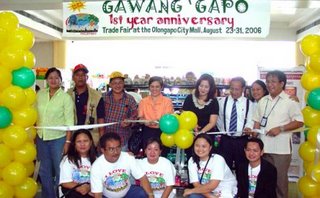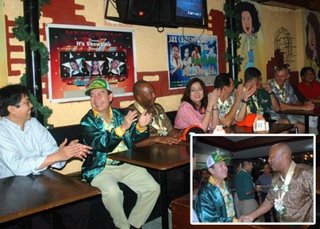Ships sent to defuse ‘ecological time bomb’
By Nestor P. Burgos Jr., Carla Gomez, Jhunnex Napallacan, Leila Salaverria
Inquirer
JORDAN, Guimaras—Seeking to defuse what experts warned was a ticking ecological time bomb, President Macapagal-Arroyo ordered the deployment of more ships, equipment and personnel to check what has become the country’s worst oil spill disaster.
The presidential order came as Philippine Coast Guard officials yesterday said they had no capacity to salvage the sunken tanker MT Solar I off Guimaras Island or stop the leaking of bunker oil into the seas.
The PCG and the environmental group Greenpeace called on the public to donate relief goods and oil cleanup implements—such as absorbent materials like foam, rice straw and even human hair.
Hair has proven effective in absorbing oil and Greenpeace volunteers have been urged to check if they could get discarded hair from beauty salons and barber shops, said Greenpeace’s Athena Ballesteros.
Coast Guard officials estimate that anywhere from 200,000 to 300,000 liters of bunker fuel had spilled out of the 2 million liters carried by the tanker when it sunk off Guimaras due to bad weather.
Officials have said the accident would be the worst oil spill in the country’s history should the remaining 1.8 million liters of fuel still in the tanker seep out.
Von Hernandez, Greenpeace Campaign Director for Southeast Asia, said the group would contact experts in Europe to ask for advice regarding the salvage of the tanker.
Hernandez described the tanker as a “ticking time bomb” and said its salvage was crucial to prevent the remaining fuel from spilling out into the sea.
Area of imminent danger
The Regional Disaster Coordinating Council in Western Visayas has decided to declare certain areas under a state of imminent danger, according to Presidential Adviser for Western Visayas Rafael Coscolluela.
This would allow local government units to use their calamity fund for damage control measures, he said.
Coast Guard commandant Vice Adm. Arthur Gosingan said the full resources of the Coast Guard would be deployed to contain the spill.
Five more ships with equipment to combat oil spills and a helicopter are arriving within the week or early next week.
At least two tugboats contracted by the owner of the tanker that sank 24 miles off this island on Friday are also deployed in the area. The ships are also expected to carry relief goods for affected residents.
Foreign experts
Two British pollution experts have also arrived to help assess the damage.
“As of now there are two representatives of the International Tanker Oil Pollution Federation there,” said Virginia Ruivivar, spokesperson for Petron Corp. which chartered the tanker.
“They are assessing what needs to be done. After that we would know what kind of assistance we would be asking from the other countries,” she added.
The spill has already affected more than 200 km of coastline, covering beaches and mangroves in black sludge and threatening the livelihoods of hundreds of poor fishermen living in villages along the shore.
The tanker is lying in up to 3,000 feet of water off Guimaras.
Malacañang said concerned government agencies were working 24 hours a day “to prevent further damage to our environment and to the communities affected.”
Prevent future disasters
Press Secretary Ignacio Bunye said the PCG and the Department of Environment and Natural Resources were also conducting an investigation into the incident to prevent a repeat of similar “ecological disasters.”
The investigation is also aimed at finding out which party is liable for the spill and what reparations are necessary to rehabilitate damaged marine resources, Bunye said.
Greenpeace, along with scientists and marine experts, have agreed to help assess the impact and the damage caused by the spill, said PCG spokesperson Lt. Cmdr. Joseph Coyme.
Recovery of Solar I has proved difficult because it has gone down to a depth of 1,800 to 3,000 feet and local salvage teams do not have the capability to reach such depths, Coyme said, adding this prompted the PCG to seek international help.
Other needed materials
Other materials needed in the cleanup are tents, ocean and tent booms, gloves, face masks, shovels, sacks, plastic bags, water-resistant canvas, generators, sprayers, soap and detergents.
Hernandez said that Petron, owner of the spilled fuel, and Sunshine Maritime Development Corp., owner of the tanker, should pay for the cleanup and compensate residents whose livelihoods were affected.
“It’s not just an environmental disaster, it’s an economic disaster because fishermen depend on the integrity of those marine resources for their livelihood,” Hernandez said.
He pointed out that when the government gives out national calamity funds for the affected areas, it is the taxpayers who in effect are paying for the effects of the oil spill caused by private entities.
Hernandez also said the effects of the spilled oil might linger even after it had been cleaned up.
Affected barangays
According to him, oil contains persistent compounds, like hydrocarbons, that remain in the environment a long time and could kill marine life.
He said the hydrocarbons could form into globules which could sink under water and smother corals, kill fish larvae and destroy the feeding and nursing grounds of fish.
So far, 20 coastal barangays in the Nueva Valencia, Sibunag and San Lorenzo towns in Guimaras have been affected by the oil spill.
Coyme denied reports that the oil spill had already affected Negros Occidental.
The PCG has also been using dispersants, a liquid chemical that breaks down the composition of the oil and causes it to dissolve or sink, to prevent the fuel from reaching more coastal areas.
Coyme said the PCG’s priority was to contain the oil and stop it from reaching the shore. He said fuel was more difficult to clean up when it reached land.
Top priority
“We are moving more ships and personnel in this area. The President considers the spill as a very serious concern,” Gosingan told the Inquirer.
Gosingan said their priority was to contain the spill at sea because it would be harder if the slick reached the shoreline, as what was happening in at least 20 coastal villages of the island-province.
Capt. Luis Tuason Jr., Coast Guard commander in Western Visayas, said the Coast Guard’s Marine Environmental Protection Units had also been brought in to help contain the spill.
Tuason said the bunker fuel that had leaked from the sunken vessel could have reached from 300,000 to 350,000 liters coming from the first two of 10 cargo tanks of the vessel.
The 998-gross-ton MT Solar I was carrying 13,000 barrels or 2 million liters of bunker fuel when it sank. The tanker was contracted by Petron to deliver the fuel to the Western Mindanao Power Corp. in Zamboanga del Sur.
Senators Richard Gordon, Ralph Recto and Aquilino Pimentel Jr. called on Petron, the Subic Bay Metropolitan Authority, and nongovernment groups to help the government cope with the disaster.
Gordon asked the SBMA to make available its oil spill mitigation equipment to remove the spill in Guimaras.
Recto said Petron should clean up the mess. “The amount needed for the cleanup is just a drop in its barrel of profits,” he said.
With reports from Christine O. Avendaño, Juliet Labog-Javellana, Jerome Aning and Edson C. Tandoc Jr. and AFP






 Later in the day, the faculty members and officials of Philippine Merchant Marine Academy (PMMA) headed by its president Fidel E. Dinoso also distributed relief good to more than hundred families from barangay La Paz.
Later in the day, the faculty members and officials of Philippine Merchant Marine Academy (PMMA) headed by its president Fidel E. Dinoso also distributed relief good to more than hundred families from barangay La Paz. 





